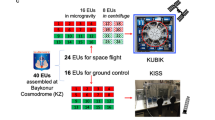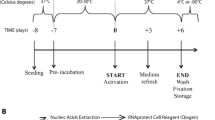Abstract
The cardiovascular system is assumed to be one mostly affected by space flight. Endothelial cells (ECs) are involved significantly into adaptation of the vascular tree to negative effects of space flight, microgravity in particular. The basal level of EC activity could determine the response of EC lining to real or simulated microgravity. Here we examined the effects of short-term 24 h exposure at random positioning machine (RPM) in order to simulate microgravity (sµg) on inflammatory activation by TNF-α and the combined effect thereof on interleukin transcription/production in ECs. EC samples were discriminated into groups relating to high (ECs-1) or low (ECs-2) basal ratio of ICAM-1 positive cells. ECs-1 displayed a higher basal level of IL-8, while the elevation after TNF-α exposure was more pronounced in ECs-2 (3.3 vs 15 folds). TNF-α-induced IL-6 elevation was 2.9- and 7.1-folds in ECs-1 and ECs-2 respectively. A short-term sµg had no effect on IL-6 and IL-8 production and on IL6 and IL8 transcription in ECs of both groups. Combined sµg-TNF-α exposure did not affect TNF-induced elevation of interleukin levels. Herewith, more pronounced upregulation of IL8 and downregulation of IL6 in ECs-2 was observed. Above data suggest that ECs-1 are in a pre-activated and/or increased reactivity state, while ECs-2 are capable to react on microenvironmental alterations more properly. Thereby, the use of primary cultures of endothelial cells for space flight or simulated microgravity experiments requires a more precise evaluation of their functional steady state.



Similar content being viewed by others
Availability of Data and Material
The datasets generated during and/or analyzed during the current study are available from the corresponding author on reasonable request.
References
Ahn, K.: A permanent human cell line (EA.hy926) preserves the characteristics of endothelin converting enzyme from primary human umbilical vein endothelial cells. Life. Sci. 56, 2331–2341 (1995)
Al-Soudi, A.: Endothelial cells: From innocent bystanders to active participants in immune responses. Autoimmun. Rev. 16, 951–962 (2017)
Balsamo, M.: Molecular and Cellular Characterization of Space Flight Effects on Microvascular Endothelial Cell Function – Preparatory Work for the SFEF Project. Microgravity. Sci. Technol. 26, 351–363 (2014)
Barnes, T.C.: The Many Faces of Interleukin-6: The Role of IL-6 in Inflammation Vasculopathy and Fibrosis in Systemic Sclerosis. Int. J. Rheumatol. 2011, 1–6 (2011)
Borst, A.G., van Loon, J.J.W.A.: Technology and Developments for the Random Positioning Machine RPM. Microgravity. Sci. Technol. 21, 287–292 (2009)
Buravkova, L.: Cell-to-cell interactions in changed gravity: ground-based and flight experiments. Acta. Astronaut. 57, 67–74 (2005)
Buravkova, L.B.: The role of cytoskeleton in cell changes under condition of simulated microgravity. Acta. Astronaut. 48, 647–650 (2001)
Buravkova, L.B.: The ICAM-1 expression level determines the susceptibility of human endothelial cells to simulated microgravity. J. Cell. Biochem. 119, 2875–2885 (2018)
Carlsson, S.I.: Endothelial stress by gravitational unloading: effects on cell growth and cytoskeletal organization. Biochim. Biophys. Acta. 1642, 173–179 (2003)
Cotrupi, S.: Impact of modeled microgravity on microvascular endothelial cells. Biochim. Biophys. Acta. 1746, 163–168 (2005)
Freidlin, I.S.: Immunophysiology of endothelial cells. Fiziol. Cheloveka. 32, 124–135 (2006)
Ferranti, F.: Advantages and Limitations of Current Microgravity Platforms for Space Biology Research. Appl. Sci. 11, 68–85 (2021)
Gravina, A.G.: Vascular Endothelial Dysfunction in Inflammatory Bowel Diseases: Pharmacological and Nonpharmacological Targets. Oxid. Med. Cell. Longev. 2018, 2568569 (2018)
Griffoni, C.: Modification of proteins secreted by endothelial cells during modeled low gravity exposure. J. Cell. Biochem. 112, 265–272 (2011)
Hauslage, J.: Pyrocystis noctiluca represents an excellent bioassay for shear forces induced in ground-based microgravity simulators (clinostat and random positioning machine). NPJ. Microgravity. 3, 12–19 (2017)
Herranz, R.: Ground-Based Facilities for Simulation of Microgravity: Organism-Specific Recommendations for Their Use and Recommended Terminology. Astrobiology 13, 1–17 (2013)
Infanger, M.: Modeled gravitational unloading induced downregulation of endothelin-1 in human endothelial cells. J. Cell. Biochem. 101, 1439–1455 (2007)
Krüger, M.: Growth of endothelial cells in space and in simulated microgravity – A comparison on the secretory level. Cell. Physiol. Biochem. 52, 1039–1060 (2019)
Langer, H.F.: Leukocyte - endothelial interactions in inflammation. J. Cell. Mol. Med. 13, 1211–1220 (2009)
Li, D.: Tumor necrosis factor-alpha enhances hypoxia-reoxygenation-mediated apoptosis in cultured human coronary artery endothelial cells: critical role of protein kinase C. Cardiovasc. Res. 42, 805–813 (1999)
Li, A.: Autocrine Role of Interleukin-8 in Induction of Endothelial Cell Proliferation Survival Migration and MMP-2 Production and Angiogenesis. Angiogenesis 8, 63–71 (2005)
Li, N.: Microgravity-Induced Alterations of Inflammation-Related Mechanotransduction in Endothelial Cells on Board SJ-10 Satellite. Front. Physiol. 9, 1025 (2018)
Livak, K.J.: Analysis of Relative Gene Expression Data Using Real-Time Quantitative PCR and the 2−ΔΔCT Method. Methods 25, 402–408 (2001)
Makó, V.: Proinflammatory activation pattern of human umbilical vein endothelial cells induced by IL-1β TNF-α and LPS. Cytometry a. 77, 962–970 (2010)
Mariotti, M.: Gravitational unloading induces an antiangiogenic phenotype in human microvascular endothelial cells. J. Cell. Biochem. 104, 129–135 (2008)
Muid, S.: Interleukin-6 and intercellular cell adhesion molecule-1 expression remains elevated in revived live endothelial cells following spaceflight. Malays. J. Pathol. 35, 165–176 (2013)
Pober, J.S.: Evolving functions of endothelial cells in inflammation. Nat. Rev. Immunol. 7, 803–815 (2007)
Ribatti, D.: Endothelial cell heterogeneity and organ specificity. J. Hematother. Stem. Cell. Res. 11, 81–90 (2002)
Shcheglovitova, O.N.: Differences in functional activity of cultivated human vascular endothelium cells derived from various donors. Cell. Tissue. Biol. 5, 353–357 (2011)
Strober, W.: Trypan Blue Exclusion Test of Cell Viability. Curr. Protoc. Immunol. 111, A3.B.1-A3.B.3. (2015)
Sumanasinghe, R.D.: Expression of proinflammatory cytokines by human mesenchymal stem cells in response to cyclic tensile strain. J. Cell. Physiol. 219, 77–83 (2009)
Tanaka, T.: IL-6 in Inflammation Immunity and Disease. Cold. Spring. Harb. Perspect. Biol. 6, a016295 (2014)
Ulbrich, C.: Effects of basic fibroblast growth factor on endothelial cells under conditions of simulated microgravity. J. Cell. Biochem. 104, 1324–1341 (2008)
Versari, S.: Alterations of the actin cytoskeleton and increased nitric oxide synthesis are common features in human primary endothelial cell response to changes in gravity. Biochim. Biophys. Acta. 1773, 1645–1652 (2007)
Versari, S.: The challenging environment on board the International Space Station affects endothelial cell function by triggering oxidative stress through thioredoxin interacting protein overexpression:the ESA-SPHINX experiment. FASEB. J. 27, 4466–4475 (2013)
Wang, Q.: Transcriptome Analysis Revealed Inflammation Is Involved in the Impairment of Human Umbilical Vein Endothelial Cells Induced by Post-hemorrhagic Shock Mesenteric Lymph. Front. Immunol. 11, 1717 (2020)
Ward, J.H.: Hierarchical Grouping to Optimize an Objective Function. J. Am. Stat. Assoc. 58, 236–244 (1963)
Wuest, S.L.: Simulated Microgravity: Critical Review on the Use of Random Positioning Machines for Mammalian Cell Culture. Biomed. Res. Int. 2015, 1–8 (2015)
Yang, L.: Endothelial Cell Cortactin Coordinates Intercellular Adhesion Molecule-1 Clustering and Actin Cytoskeleton Remodeling during Polymorphonuclear Leukocyte Adhesion and Transmigration. J. Immunol. 177, 6440–6449 (2006)
Zhou, J.: Genomic-scale analysis of gene expression profiles in TNF-a treated human umbilical vein endothelial cells. Inflamm. Res. 51, 332–341 (2002)
Acknowledgements
This work was supported in part by the Basic Research Program of the Institute of Biomedical Problems Russian Academy of Sciences (project no. 65.3) and by the Russian Science Foundation (project no. 16-15-10407).
Funding
This work was supported in part by Program of Basic Research of IMBP RAS (project no. 65.3) and by the Russian Science Foundation (project no. 16–15-10407).
Author information
Authors and Affiliations
Contributions
Evgeny G. Rudimov and Yulia V. Rudimova performed the experiments and analyzed the data; Evgeny G. Rudimov and Yulia V. Rudimova, Elena R. Andreeva wrote original manuscript; Lyudmila B. Buravkova supervised the design and execution of the study and critically revised the manuscript.
Corresponding author
Ethics declarations
Ethics Approval
All procedures were approved by the Biomedicine Ethics Committee of the Institute of Biomedical Problems, Russian Academy of Sciences (Permit #288/END/10/05/11).
Consent to Participate
All authors have consented to participate.
Consent for Publication
All authors have consent for publication.
Conflicts of Interest/Competing Interests
No conflicts or competing financial interests exist.
Additional information
Publisher's Note
Springer Nature remains neutral with regard to jurisdictional claims in published maps and institutional affiliations.
Rights and permissions
About this article
Cite this article
Rudimov, E.G., Rudimova, Y.V., Andreeva, E.R. et al. Simulated Microgravity Affects the TNF-α-Induced Interleukin Profile of Endothelial Cells Depending on the Initial ICAM-1 Expression. Microgravity Sci. Technol. 34, 1 (2022). https://doi.org/10.1007/s12217-021-09920-5
Received:
Accepted:
Published:
DOI: https://doi.org/10.1007/s12217-021-09920-5




